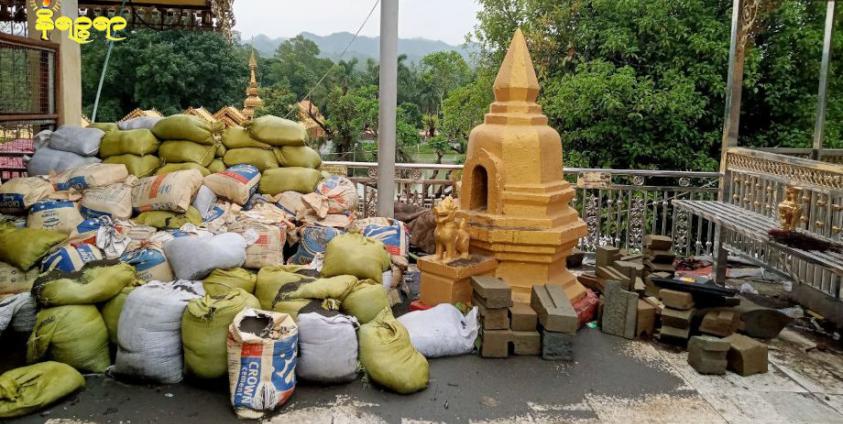Local Rakhine people are calling for the withdrawal of Military Council troops from sacred pagodas and temples in Rakhine State, as the fighting has stopped in the region following a ceasefire agreement.
The presence of Military Council troops in the historical pagoda precincts caused inconvenience for local Buddhists who wanted to visit and perform rituals on religious days. They voiced their concerns about the difficulty of accessing the pagodas.
The Military Council troops are currently stationed at the 31-Realm Pagoda in Buthidaung, which has prevented residents of nearby villages such as Nwar Yoan Taung, San Go Htaung, Shi Shar Taung, and Ou-Yin Thar from returning home. These villagers are still displaced and forced to live elsewhere. One resident of Nwar Yoan Taung expressed their desire for the military to vacate the pagoda area now that the conflict in the region has ended.
“We have witnessed the shelling and burning of our villages, forcing us to flee to safety. But now, we yearn to return to our homes. However, such repatriation demands extensive rehabilitation, demining of the surrounding areas, and the withdrawal of soldiers stationed near the pagoda. Moreover, soldiers shall not be stationed within the pagoda premises during the truce”, the villager said.
Residents of these villages have been forced to flee the conflicts and seek refuge in refugee camps such as Lan Ma, Mya Taung, and Yan Aung Myay in Buthidaung. They have been living
there for an extended period of time.
During 2019, 2020, and 2022, Military Council troops were deployed to several famous pagodas
and their surrounding areas in Rakhine State including 31-Realm Pagoda in Buthidaung Township, Kyauktaw Pagoda and Mahamuni Buddha Image Square in Kyauktaw Township, Aung Mingalar Pagoda in Pan Myaung village in Minbya Township, Kyein Taung Pagoda in Minbya, and Maha Zeyar Theidi Aung Taw Mu Pagoda on Mru Hill near Say Ti Pyin Village in Rathedaung Township.
The Aung Mingalar Pagoda, situated on a mountain in Minbya, is still occupied by Military Council troops, preventing local villagers from accessing the site, a villager said.
“ As locals, we have repeatedly requested that they leave, but unfortunately, nothing has changed. With Thingyan (Myanmar New Year) fast approaching, we are eager to visit the pagoda near our village and perform good deeds”, he told Narinjara.
Military Council soldiers are still stationed in the premises of Kyauktaw Pagoda, but pilgrims are still permitted to visit the site.
However, during the 5-day Pagoda Festival, held from March 3rd to 7th, the Military Council troops garrisoned in Mahamuni Buddha Image compound temporarily withdrew, allowing the pilgrims to visit the image without any disturbance, locals said.
At Kyein Taung Pagoda in Minbya, the Military Council troops permit pilgrims to enter only for a limited time on Saturdays and Sundays each week, a Minbya local said.
“The visiting hours to the pagoda are restricted from 8:00 AM to 4:00 or 5:00 PM, and while there are no physical inspections of the pilgrims, photography of the surrounding scenery is prohibited”, he explained.
Despite repeated requests from monks and local residents, no action to withdraw military deployments from the squares of pagodas and stupas has been taken.
The board of trustees of the Maha Zeyar Theidi Aung Taw Mu Pagoda, located at the foothill of Mru near the Saytipyin-Kyaukpanu Inndin highway in the western part of Rathedaung Township, has submitted a formal request to refrain from deploying Border Guard Forces (BGF) at their site.
In their letter dated February 19th, the board of trustees expressed their desire to uphold the stability of the region by continuing their efforts to promote Buddhism, and they requested that no armed organizations be stationed on the premises of the pagoda.
Locals have raised concerns over the presence of soldiers in religious buildings, even though an informal ceasefire between the Military Council and the Arakan Army (AA) has been in place in Rakhine State for about three months







